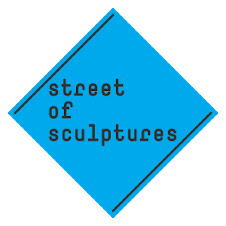The first appointment was with Achfaaq Mohamedjoessoef and Emmanuel Koney. Achfaaq is the director of the child care organisation Yoesboef. He is also the organiser of the internationally known Bijlmer Checkers Tournament. Emmanuel is the charismatic minister of the Pentacost Revival Church. Thomas came well prepared; he had list of questions, such as ‘what does art mean to you and your community?’, ‘ what would be a good site for an art work?’, ‘Do you know Spinoza’? etc. It was a very good meeting: both Achfaaq and Emmanuel were very honest and open, offering encouragement and as well as caution.
Then we had to race to De Nieuwe Stad, where we met Henk de Boer, the beadle of this church building, shared by 5 different parishes. To our surpirse, Henk had made print outs for Thomas of all public art works in the Bijlmer, with pictures and details of the works. Our next stop was Sammy Monsels, a former 6-time sprint champion and founder of the Bijlmer Athletic Club. Sammy had just finished his coaching duties, so we had tea in his office next to the track. It turned out his activities and drive encompasses much more than just athletics: the work he does has immense social significance within the Bijlmer community, especially among the youth. In 2004 he received a royal award for his efforts.
We ended the day with diner at Mavis – and her food was as fantastic as ever. Even during diner, Thomas did not stop working, interviewing the cooks and other kitchen personnel while enjoying his roti.
After diner, we had the final meeting of the day, with long time Bijlmer resident Henk van de Belt, with whom we talked about the Bijlmer plane crash disaster and its aftermath.
The next morning we went to see Ina Liebregts. Unfortunately, she had fallen ill, so we had to cut our visit short. This meant we had some time left, so we paid an unannounced visit to RaZo, the local multicultural radio- and television station. There we talked to Ibrahim and Mufti, Ghanese radio presenters who had just finished their broadcast, while Kees Kunta Kinte did his radio show in the background. We hung around for half an hour, enjoying the company, the coffee and the conversation. And then it was off again to the train station, back to Paris.
All in all both Thomas and I were very pleased with the results. The people we met were all very different, with various perspectives, but all were very open and appreciative. I can’t wait for the next phase in the research, which will start in June.




















